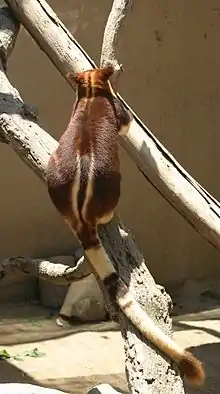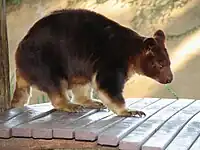Buergers' tree-kangaroo
The Buergers' tree-kangaroo (Dendrolagus goodfellowi buergersi)[1][2] is a subspecies of the Goodfellow's tree-kangaroo from Papua New Guinea, where they dwell mainly in tropical rainforests. Their diet consists of mostly leaves and fruit, which they find both in trees and on the ground.
| Buergers' tree-kangaroo | |
|---|---|
 | |
| Scientific classification | |
| Domain: | Eukaryota |
| Kingdom: | Animalia |
| Phylum: | Chordata |
| Class: | Mammalia |
| Infraclass: | Marsupialia |
| Order: | Diprotodontia |
| Family: | Macropodidae |
| Genus: | Dendrolagus |
| Species: | |
| Subspecies: | D. g. buergersi |
| Trinomial name | |
| Dendrolagus goodfellowi buergersi Matschie, 1912 | |
It is believed tree-kangaroos evolved from creatures similar to modern kangaroos and wallabies. The ancestors of all kangaroos are thought to be small marsupials that look like present-day opossums.
Tree-kangaroos have developed long tails for balancing in the trees, and strong forelimbs for climbing. Their teeth are developed for tearing leaves rather than cutting grass.
The Buergers' tree-kangaroo, along with nine other species of tree-kangaroo, are endangered and on the brink of extinction. The key threats to their survival include dwindling habitat due to logging; mining; road kill by humans and predation by domestic and wild dogs.
Gallery
See also
References
- "Dendrolagus goodfellowi buergersi". Integrated Taxonomic Information System.
- Wilson, Don E.; Reeder, DeeAnn M. (2005). Mammal Species of the World: A Taxonomic and Geographic Reference (3 ed.). Baltimore, Maryland: Johns Hopkins University Press. p. 2142. ISBN 978-0801882210.


